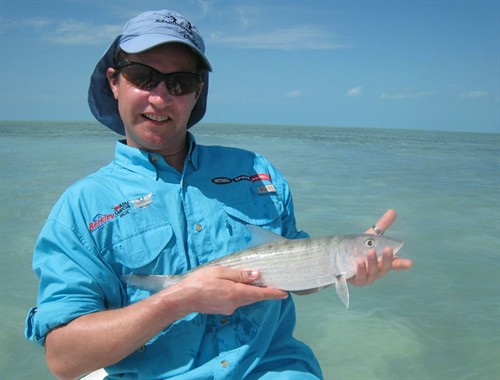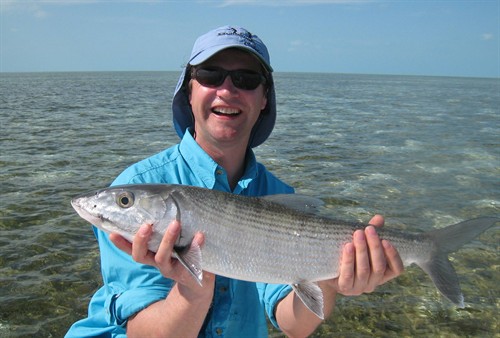About Bonefish
The worlds strongest fish if you measure it by power per pound...

The Bonefish is living in inshore tropical waters, moving onto
shallow tidal flats to feed with the incoming tide, and retreating
to deeper water as the tide ebbs.
Bonefish may be observed in large shoals of like-sized
individuals with large mature fish swimming in smaller groups or in
pairs.
They use their conical snouts to root around in the sand/mud at
the bottom to dislodge worms, mollusks, shrimps and crabs. When the
fish eats like this you could se it as "tailing"(their tails
sticking out of the water, and you could also hear the fluttering
of them in the surface)
In areas with muddy bottom you can also observe areas of "milky"
water when the fish searches for food.
Flies & Equipment
Bonefish Flies:
Shrimps like Chrazy Charlie, Gotcha, Mini-puff and Snapping
Shrimp. Recomended size of the flies is 4 to 6. The color of the
flies should compare with the colour of the sand/mud where you
fish.
Rod:
A rod of 7 or 8 wt would be preferred.
Due to wind conditions out on the flats, a mid or tip flex rod
is recommended.
(In the summertime when a bigger amount of smaller Bonefish is
present, you could try a 6 wt rod.)
Reel:
A saltwater resistant Large arbour reel(with a good and smooth
drag), that suits your rod and takes 200 meters backing plus your
fly-line.
Spare spool with extra line is recommended.
It would be booooring to lose or destroy your line or backing
first day out fishing, without a back up.
Line/backing:
Fly line that suits your rod/reel.
Some people put on a line one wt higher than the rod, to add
some more weight for casts in windy conditions. You should try out
what suits your casting-technique and rod before your trip.
You better use a line made for warm conditions(tropical) in
neutral colour. Lines that people normally use for Sea Trout
in Norway/UK will get to "soft" during these warm conditions, and
you could get challenges with your casts. These lines are normally
100ft, and with welded loops for easy rigging. Fishing on the
flats, we recommend floating lines, but intermediate could be used
on deeper water.
We normally use High Vis. Fireline 0,25 mm for backing, which we
find better during fights close to mangroves.
Leaders/tippets:
We prefer Fluorcarbon leaders/tippets for its invisibility in
the clear water and high abrasion resistance. Some guides say that
Fluorcarbon are not that good, but the reason may be that they find
it harder to make their normal knots on these tippets.
Leaders should be 10-12 ft and 14-16lb(1X and 01X)
Spool of Fluorcarbon tippet 1X and 01X to replace lost inches of
your leader after changing flies.
With to thin tippets you have to fight the fish longer, which
will make the recovery harder for the Bonefish and make it highly
vulnerable for predators..
How to catch and land Bonefish
It is important to present your fly right, no matter how
the fish swims. If you manage to present your fly right, you will
see that the fish have spotted your fly when it speeds up towards
your fly.
Remember that even if the fish swims towards your fly, keep on
moving the fly by stripping your line 20-30 cm at each strip with
some short pauses in between.
Often the Bonefish will follow your fly meeter by meeter, and it
could actually been tasting your fly several times even if you
havent felt anything. Its sometimes hard to feel if the fish takes
your fly, since it often sucks it up gently.(If you feel any
resistence when you know the fish is following your fly, take a
fast firm strip to hook the fish.) When the fish takes your fly
give a fast and firm strip to your line to hook the fish, and raise
your rod. Using the normal reflexes a trout fisher have is useless
in the hard mouth of the Bonefish, you either loose your fly or the
fish.. If you have hooked the fish right, things will happend FAST!
All your loose line will run out through the rings on your rod in a
second, then the reel will have to do the job.
In advance you must be sure that there is nothing around you that
the fly line could get trapped in, such as sandals, fly west
hooks/rings/tools, and any loose items in the boat. Keep the rod
up, and keep a smooth pressure until the fish stoppes its first
run. Keep the line tight and try to give the fish as hard fight as
you can. Dont play more than neccesary with the fish as both Sharks
and Barracudas often attack tired Bonefish. Sometimes you even see
that the Barracuda tries to take your fish while you are fighting
it. Pick up the fish, take your photo and the release it gently
into the water. If the fish is tired, "pump" it forward and
backward untill it takes off. Then you can wash the slime of your
hands(the Bonefish got a slimy layer which protects the skin) To be
sure that you dont harm the fish more than neccesary, please remove
the barb on your hook, so you could take the hook out gently
without harming its mouth.





